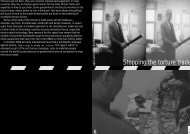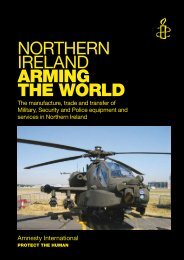CROWD CONTROL TECHNOLOGIES - Omega Research Foundation
CROWD CONTROL TECHNOLOGIES - Omega Research Foundation
CROWD CONTROL TECHNOLOGIES - Omega Research Foundation
You also want an ePaper? Increase the reach of your titles
YUMPU automatically turns print PDFs into web optimized ePapers that Google loves.
6.3.1 Calmatives The human brain has thousands of so called receptor sites. A receptor has been<br />
defined by Dr. Mathew Meselson as a )molecule on a cell which when a certain other kind of molecule<br />
called a ligand binds to it, causes something to happen.( For example )There are receptors in our brain<br />
called opioid receptors. The body manufacturers molecules called enkephalins and endorphins, which<br />
bind with these receptors; if the proper molecule binds to some of these receptors it alleviates pain, or<br />
brings on sleep, or slows down breathing or affects various emotions(. 328 As discussed in 6.4 (below)<br />
the Human Genome project will map these receptor sites, and eventually those which evoke sleep,<br />
obedience, submission, sexual display etc. The US military have undertaken research on these<br />
receptor sites for many years. )Of the few that have been identified, some can cause temporary<br />
blindness; can make you think you are smelling something that is not there; can cause submissiveness<br />
or extreme anxiety(. 329<br />
Meselson informs us that a few synthetic chemicals bind very specifically to opioid receptors and<br />
induce sleep. From these have been developed chemical crowd control weapons many of which are<br />
based on analgesics which induce sleep, called calmatives. One of this group of chemicals is the<br />
fentanyl family of morphine like analgesics, which started to be examined in CBW labs around 1963,<br />
after which they were introduced into surgical practice as injectable anaesthetics. 330 Certain derivatives<br />
of fentanyl e.g. carfentanyl are extremely toxic, more so than nerve agents like VX with ten micrograms<br />
per kilogram body weight being able to induce paralysis. However, one defect is potential fatalities<br />
since these opioids can cause respiratory collapse. A second family referred to in the open literature<br />
are the bis-quaternary pyridium compounds which were evaluated alongside the fentanyls and<br />
cogeners in 1984. Other candidate analgesics for disabling weapons include (some only given code<br />
names) EA 3382[a dart gun paralysant for clandestine ops]; the benzomorphans oripavine and<br />
thebaine; TL 2636 and its iso-amyl cogener M-140; etophine(used in the chemical restraint of large<br />
animals); the phenothiazine family (such as EA 5202); butyrophenone tranquillisers(such as CAR<br />
302,089, the 3-methyl homologue of spirodol) and the anticholinergic glycollates of which there are<br />
several hundred. Some of these produce mental confusion, elevated blood presure, vomiting,<br />
prostation and coma and their effects can last for just a short duration(e.g. EA 3834 and CAR 302,668),<br />
others last hours or even days (e.g.EA 3167). In the mid seventies, work was undertaken to spread<br />
these agents via a solution in the sensory irritant methoxycycloheptatriene, possibly with the skin<br />
transferral agent DMSO. The US Chemical Corp issued a technical memorandum proposing several of<br />
these agents as candidates for law enforcement and riot control. 331 In 1991, this incapacitating<br />
chemical program was transferred to a new budget head - the )Advanced Riot Control Agent<br />
Technology( or ARCAT. 332<br />
It should be remembered that the US for the purposes of the Chemical Weapons Convention<br />
(CWC) has a different set of definitions on what is permissible and what is excluded for riot control<br />
under the general purpose criterion of the convention. Under Executive order 11850 of April 1974, four<br />
examples are given where the US can use riot control agents, namely; (a) )in riot control situations in<br />
areas under direct and distinct US military control, to control rioting prisoners of war; (b) in situations in<br />
which civilians are used to mask or screen attacks and civilian casualties can be reduced or avoided;<br />
(c) in rescue missions in remote isolated areas, of downed aircrews and passengers and escaping<br />
prisoners and (d) in rear echelon areas outside the zone of immediate combat to protect convoys from<br />
civil disturbances, terrorists and paramilitary organizations(. 333<br />
It does not take much imagination, given the failure of the CWC to define domestic riot control and<br />
law enforcement, that in operations other than war, such as peacekeeping missions, the US might feel<br />
it was legitimate to deploy new agents and dissemination systems. By 1991 the US Army said they now<br />
had a device which )could deliver a potent riot control compound.( They advised )A class of<br />
compounds has been selected and viable analogues are under evaluation for acceptability in meeting<br />
initial generic requirements(. 334 It is likely that these agents are part of the fentanyl family. 335 In<br />
operational circumstances, it is very difficult to control levels of individual intake and one persons<br />
sleeping draft would be anothers lethal dose. Used in conjunction with lethal weapons or where a<br />
crowd was fleeing, additional fatalities could occur from either falling or crush injuries or simply being a<br />
l




